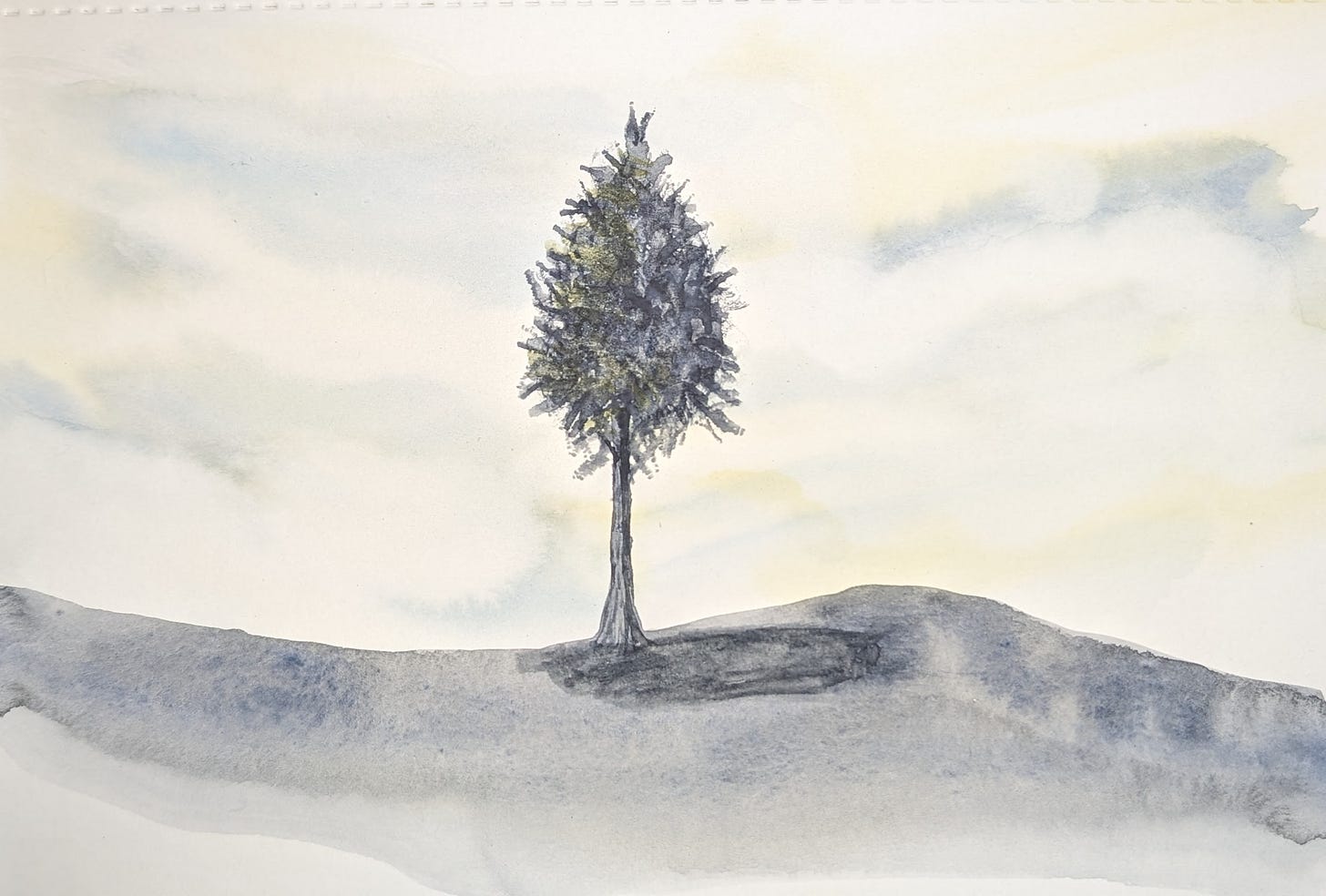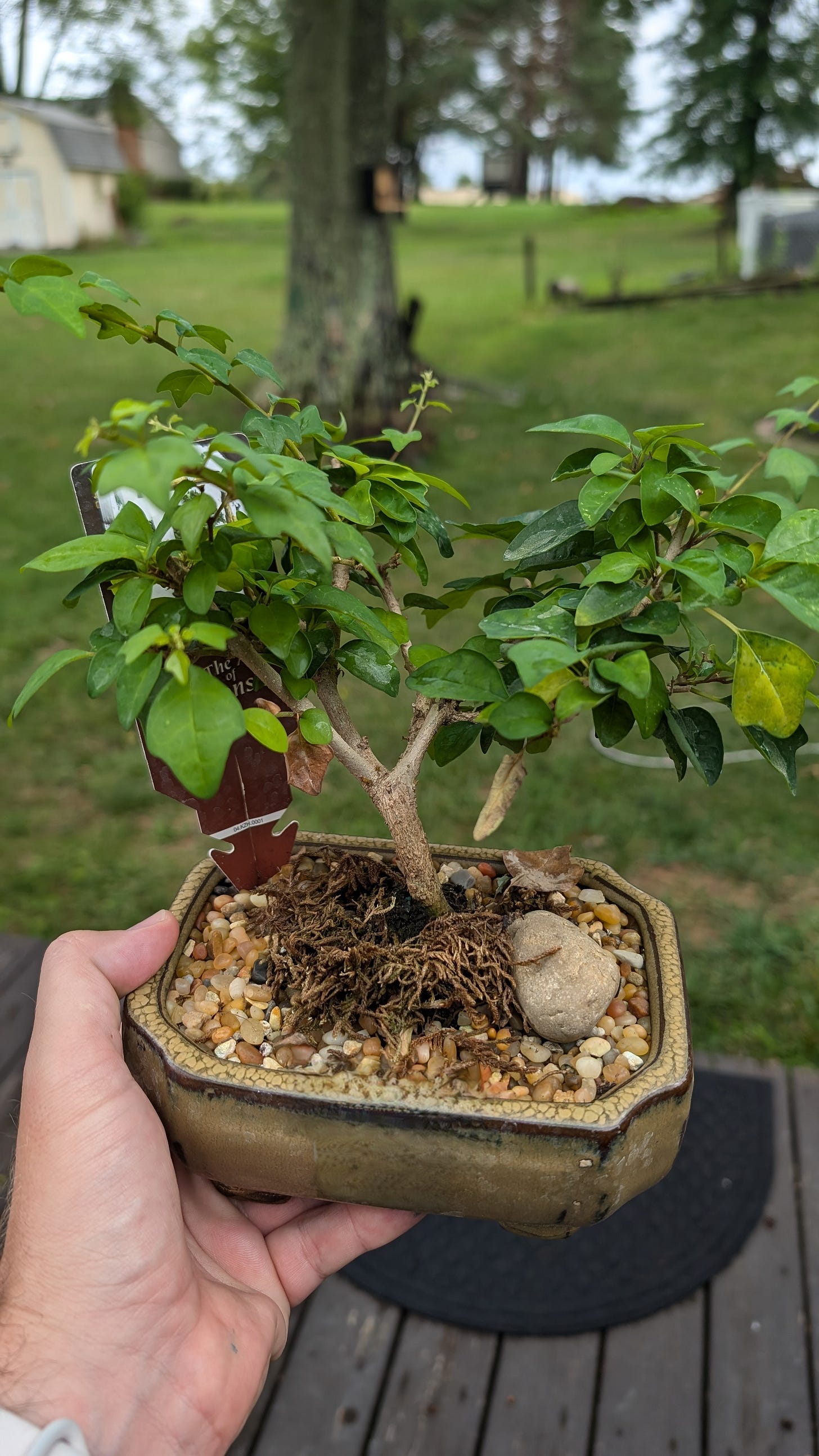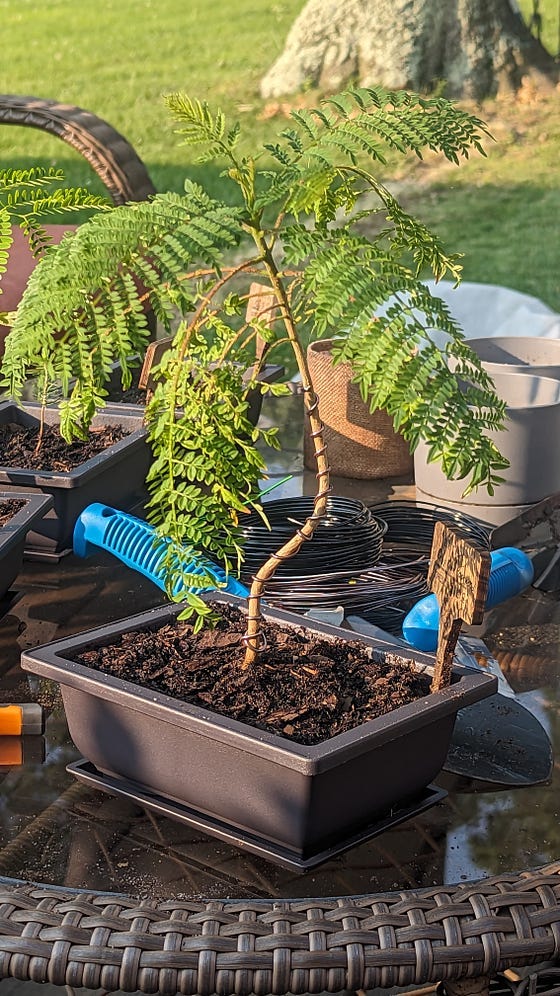Since I was a young boy, something about a live, miniaturized tree appealed to me. Perhaps because the world can seem so big when you’re a kid, a miniature world provides an entirely new perspective. Finally reaching a lifelong goal in 2022, I planted four bonsai trees when my wife and kids bought me a kit. It was my first sober summer, and I was looking for new and interesting hobbies that didn’t involve drinking.
I didn’t know what bonsai was at the time. I thought they were genetically modified seeds that made small trees. They’re not. Trees kept small by scientific means is a technique called dwarfing, and dwarfed plants are permanent genetic miniatures of existing species. Bonsai is different because it’s the process of training regular trees to remain small. Most bonsai hobbyists start with saplings or small plants, but I wanted the real deal so I started from seeds. At the time, I didn’t know I’d be adding several years to the journey.
Bonsai is an art form that involves cultivating techniques that limit growth by pruning, root-trimming, and keeping the trees in small pots. They are regular trees, trained over long periods. I saw an orange bonsai the other day that produces tiny fruits, and I’m dying to train one. It'll be here this weekend.
My wife didn’t know she was creating a monster.
There is a young tree in my front yard that has special meaning to me. It’s about to turn three years old, and it is my horticultural generational equal. In other words, it’s the third generation and a direct descendant of one my grandfather cared for.
By cared for, I mean tried to kill for years.
He did not want this tree. He ran it over with the lawnmower weekly. He chopped it down before it was a foot high. He poured oil on it. He painted tar on it. He poured gasoline over it, lit it on fire, and danced on its smoldering remains while singing a disturbing version of Let There Be Peace On Earth.
But each spring it would return with a drive to survive. After a few years, he determined that the tree deserved to live, and it grew big and strong and became a lovely tropical umbrella for their yard overlooking the fish pond. It looked like something out of a zen garden. The tree and the pond below were a source of peace and serenity throughout my childhood.
Over the years, the offspring of the tree would sprout in random locations around the yard, and we were able to transplant a few of them to new homes as we grew as a family. As of this year, some 40 years later, the third generation of that tree blooms on my front lawn.
When it first sprouted in my grandparent’s yard all those years ago, nobody knew where the tree came from. There weren’t any others like it in the neighborhood. I wondered if maybe a Japanese chipmunk ate a mimosa seed pod and then stowed away on a rogue cargo plane, then jumped out of the landing gear hole and landed in their yard.
I’ve since learned that this tree I’ve always admired is an invasive species. Also known as a Persian Silk Tree, our little Mimosa refused to die because it wanted to take over the world with its silky little flowers and mutant-like growth rate. Mimosas grow like bad weeds. They can grow far faster than indigenous plant species, rob them of sunlight and nutrients, and take over before you know it. It also aggressively carpet-bombs your yard with thousands of seed pods in a shameless attempt to reproduce.
Knowing they’re invasive doesn’t change the way I feel about this tree. Still, perhaps it’s better suited to be contained and ornamental instead of allowed to run roughshod on landscapes in warm climates.
When I learned that most trees are capable of becoming bonsais, I couldn’t wait to try it on my beloved—however invasive—heirloom mimosa tree.
The idea for bonsai was originally Chinese, but Buddhist students brought it back to Japan after visiting and studying there. Starting after the 6th century A.D., over hundreds of years, they brought back Chinese ideas and goods, and small potted plants were one of them.
The concept of bonsai evolved into an art form. Some cultures used them in larger nature scenes to depict entire landscapes, but I’m fascinated with the aesthetics. Like so many hobbies and arts, groups of enthusiasts have conventions and exhibitions to show off these works of art, and there are many disciplines that go into caring for and shaping them.
The size of the pot is the key to keeping them small. You also have to trim the branches in seemingly barbarous ways, but ruthless trimming is necessary to get a real tree to maintain a miniature aesthetic.
When my little trees sprouted in 2022, I cared for them like pets. I talked to them, encouraged them, and protected them. This year I bought a temperature-controlled indoor nursery to keep them safe and warm over the winter. I lost a few last winter, but am happy to say that 2 of them are now approaching 3 years old. Now I’m invested. Now I REALLY don’t want to lose them.
I’ve learned a handful of interesting techniques to shape and train them over many years, and measures are taken to prevent unsightly and unnatural marks on their trunks. I’m learning to train them while keeping them looking natural.
The year before I dove into bonsai I had read Robert Macfarlane’s Underland: A Deep Time Journey. I was bowled over by a chapter called The Understory.
The chapter is about the forest floor and the hidden secrets beneath our feet. It’s about the amazing ways trees have learned to communicate via an underground network and have learned to share resources. We learn about a forest ecologist named Suzanne Simard, and how she uncovered some amazing forest secrets.
She injected radioactive isotopes into one type of tree and stable isotopes into another. She then traced the isotopes and mapped communication through the underground fungal network and discovered that trees can communicate, share resources, and even warn one another of danger.
Simard’s inquiries confirmed that beneath her forest floor there did indeed exist what she called an “underground social network,” a “bustling community of mycorrhizal fungal species” that linked sapling to sapling. She also discovered that the hyphae made connections between species: joining not only paper birch to paper birch and Douglas fir to Douglas fir, but also fir to birch and far beyond — forming a non-hierarchical network between numerous kinds of plants.
Instead of seeing trees as individual agents competing for resources, she proposed the forest as a “cooperative system,” in which trees “talk” to one another, producing a collaborative intelligence she described as “forest wisdom.” Some older trees even “nurture” smaller trees that they recognize as their “kin,” acting as “mothers.” Seen in the light of Simard’s research, the whole vision of a forest ecology shimmered and shifted — from a fierce free market to something more like a community with a socialist system of resource redistribution. — Underland.
Since the research cited in Underland, Simard has done additional research and gone even deeper into the forest communication network. As it turns out, there are “mother” trees that take care of their kin and share resources.
In her TED talk, “How Trees Talk To One Another”, Suzanne takes us a little further into the relationships between trees.
Mother trees colonize their kin with bigger mycorrhizal networks. They send them more carbon below ground. They even reduce their own root competition to make elbow room for their kids. When mother trees are injured or dying, they also send messages of wisdom on to the next generation of seedlings. — Source
Underland is a magnificent thought experiment into “deep time,” which humans are woefully inept at perceiving. Trees communicate over hundreds of years, while we tend to see things in terms of our time spent on Earth. All other timeframes are abstract to us. It’s not our fault, it’s just how it is.
But all this got me thinking about my little trees sitting in their isolated pots.
Even though they are isolated and do not share the same soil, can they communicate? Should I build some sort of tunnel between the pots so they can talk to their friends and neighbors? I talk to them, but I’m not sure I speak their language.
Working with them, watching them grow, and caring for them brings me great peace. I hope they’re around long enough to take a deep time journey and tell our story to their descendants. Someday maybe I’ll plant them in nature and let them be free.
Maybe my mimosa will take over the world.
Or maybe I should put it in a small pot before it’s too late.






I have so many things to say. First of all, I’m fascinated with the plant and fungi kingdoms so this was a very enjoyable read for me.
And then, your enthusiasm and love for your bonsais just speaks directly to me in many ways. I am a big tree hugger and whisperer. This shared connection can only happen through written text if both of us have felt the same emotion with our chosen loves - trees. Thank you for expressing and sharing with us. I need more updates on your bonsais. 🤍🤍
My first boyfriend bought me a bonsai tree in 2011 for my birthday. I gingerly carried it on my lap on the plane back to school. A year later, it was dead, so my roommate and I got drunk, lit it on fire, and tossed it from our 8th floor dorm window.
Anyway, now I want another.